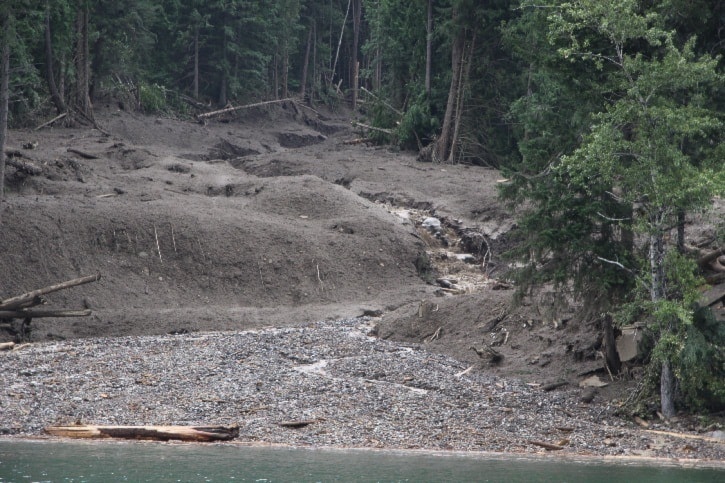Funding has been approved to replace a small water system at Johnsons Landing destroyed by the deadly 2012 landslide.
The Regional District of Central Kootenay board gave its blessing last week to spend up to $122,000 in gas tax funds on the project’s first phase, which will see a mile-long pipeline built to draw water from Upper Gar Creek.
“We’re so glad we’re going to get it sorted out,” resident Kate O’Keefe told 103.5 The Bridge. “We’ve been in the planning process for a year and a half. It’s vital. If people don’t have water they cannot live here.”
The landslide, which killed four people, destroyed an intake on the south side of the community that fed 15 domestic and 10 irrigation water licenses. Soon afterward a neighbour agreed to provide a temporary source from a spring on his property, but at times the supply didn’t meet the demand, forcing the community to tap back into the old intake.
“The next time it rained, a slurry of mud came down,” regional district director Andy Shadrack explained. “There’s no natural filtration because all the vegetation is gone. That’s why we needed to go to a different place.”
In trying to find another source, the Gar Creek water users association drilled a test well, but the results weren’t encouraging. Other sources were ruled out due to low flows and construction-related costs.
That left the option of Gar Creek above the slide area. An engineering firm was hired to design a gravity-fed system to connect to existing infrastructure, but it still isn’t cheap. While the regional district previously approved $80,000, it’s now expected to cost well over $100,000.
“It’s almost ludicrous that we have to spend so much to build a system for so few residents,” O’Keefe said. “We couldn’t possibly fund it on our own.”
The system is expected to have 12 to 18 connections — six properties remain in a high hazard zone and it’s unclear if their owners will be able to use them again.
Although the old water system didn’t belong to the regional district, directors agreed to pool $60,000 in gas tax funding for its replacement while Shadrack is providing $40,000 plus a $22,000 contingency.
The project’s first phase should be completed by November. Under an agreement with Interior Health, the second phase will see filters installed in each home, making it one of only 14 point-of-entry treatment systems in BC. Residents will be obliged to fill out inspection reports and test their water for contaminants.
That part of the project is expected to cost about $27,000. While it hasn’t been determined how it will be paid for, it’s expected to be significantly cheaper than centralized treatment.
Regional district staff cautioned the board to tie their funding for the raw water supply to successful completion of the second phase, due to concerns that unless potable water is provided, the project may not meet gas tax criteria.
However, directors unanimously agreed to disburse the funds. “It’s too onerous to put written requirements on them,” Shadrack said. “There has to be some faith. I’ve worked with them for two years and I trust them.”
For O’Keefe, it’s a bit of good news for a community that hasn’t had much in the last two years: “We are delighted. Without a reliable water system, people in Johnsons Landing who have already lost so much will be left seeking another place to live.”
